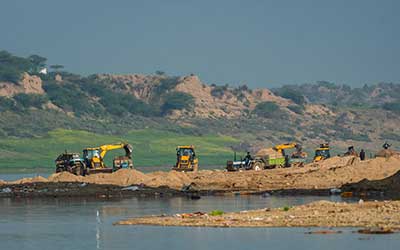Relevance: GS-3: Economic Development, Biodiversity, Environment, Security and Disaster Management.
Key Phrases: Ecocide, Critically endangered, Tributaries, National Chambal Sanctuary, Gharial, Dolphin, Ecological assessments, National Green Tribunal alone.
Why in News?
- Long believed to be cursed and born from the blood of a thousand animals according to mythological retellings, Chambal, once the haven of fearsome dacoits, is today a meek witness to the massive ecocide happening right under the noses of the police and forest authorities.
Context
- Illegal sand mining in the protected riverine area continues unabated, endangering several threatened species.
About Chambal River
- The National Chambal Sanctuary (NCS), a protected riverine area, spans Rajasthan, Madhya Pradesh and Uttar Pradesh.
- Touted as the cleanest river of India, “away from all industrial pollution”, by the Madhya Pradesh Tourism Department, the Chambal flows though the sanctuary, which is home to rare wildlife.
- The river harbours some of the most pristine sandbanks, which are the basking and egg-laying habitats for the critically endangered gharial, for the endangered Indian skimmer, the critically endangered red-crowned roofed turtle, and a host of other threatened and endangered species.
- India’s national aquatic animal, the endangered Ganges river dolphin, is also spotted here.
- The area welcomes tourists and photographers from all corners of the country.
Concerns
- Lately, however, instead of being treated to sights of wildlife, visitors are witness to convoys of tractor-trolleys, diggers and excavators destroying the sandbanks along the Chambal.
- Sources have reported illegal mining occurring at breakneck speed in recent months.
- Indian skimmers, threatened river terns, mugger crocodiles and the red-crowned roofed turtles, of which less than 400 females are thought to remain in the wild, were observed in the immediate vicinity (within a 100-metre radius) of multiple sandbanks being mined.
- According to reports, rampant sand mining within NCS is forcing gharials to migrate to Kuno and Parbati rivers, tributaries of the Chambal, in search of safer egg-laying habitats.
- Conservative estimates from an on-ground investigation in January 2022 suggested that some 40,000 cubic feet of river sand was being extracted from the Chambal Bridge site alone on a typical morning.
- If unlawful mining is brazenly progressing here, less accessible sites in the interior, away from the public gaze, are likely to be witnessing more devastation.

Regulating Sand Mining
- There have been several attempts by state and central government and judiciary to restrict illegal sand mining, most notably the Supreme Court order in 2012 that banned all sand mining, including that on land less than five hectares, without the approval of Environment and Forest (MoEF).
- NGT in 2013 issued notices against violators of SC orders, existing mining leaseholders to get environmental clearance from MoEF, giving them 3 months time to do so.
- Sand mining is regulated by The Mines and Minerals (Development and Regulations Act, 1957.
Reasons behind Rampant Sand Mining
- Lack of Political Will :
- The reasons for rampant sand mining lies in the criminal-political economies of the sand mafia. That said, the ‘mafia’ is not an external evil but a home-grown, local menace.
- Attempts to eliminate illegal sand mining continue to prove futile while it has often been suggested that operations are organised by politically well-connected individuals.
- Over the past two decades, several instances of activists, journalists, and officers being harassed, assaulted or even killed for taking an anti-mining stand have been documented.
- Local Support :
- Widespread local support and participation in illegal mining ensure that activists face an uphill task and considerable personal risk.
- Information blackholes :
- The Rajasthan government’s recent decision to lease 60 sites across the State for ‘legalised’ sand mining is expected to come as some relief to protected areas.
- However, there is an information blackhole on details of these sites, which includes a lack of transparency on ecological assessments undertaken and made available in the public domain.
- Such blanket clearances for projects set dangerous precedents, making statutory requirements mere formalities.
Steps taken by Government to curb illegal sand mining practices
- A round-the-clock complaint cell has been set up at the Collectorate Control Room for the public to register complaints regarding illegal sand mining in the district.
- The cell will function for registering complaints. Appropriate directions will be given by the Additional District Magistrate (ADM) to revenue squads formed to check the illegal practice.
- Tahsildars have been asked to conduct raids, seize vehicles that engage in the illegal activity and bring them to the notice of District Collector.
- The Circle Inspector/Sub Inspector has been asked to take necessary steps to control the illegal activity by conducting raids as per the information received from the control cell.
Conclusion
- The sand and construction mafia have already destroyed the Aravallis in Haryana and Rajasthan. Now, they are causing havoc to riverine ecosystems.
- Sand mining contributes to construction of buildings, infrastructure development, it helps in extracting minerals and provides both economic and social benefits. However, intensive sand mining with disregard to environmental protection erodes these gains and creates a series of environmental problems.
Sources: The Hindu
Mains Question:
Q. Illegal sand mining in the protected riverine area continues unabated. In this context suggest measures to overcome this environmental threat ? (Words 250).







